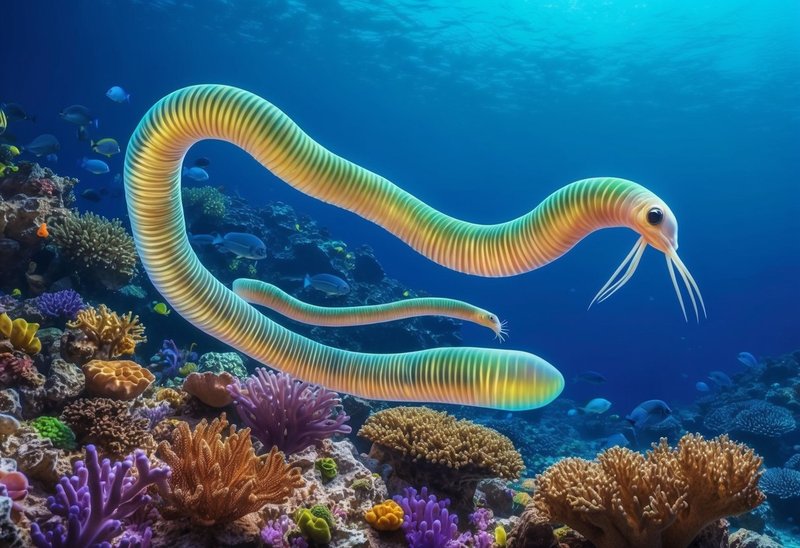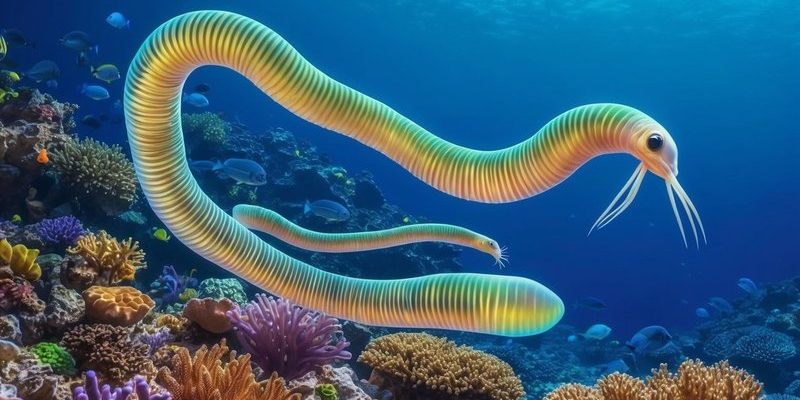
Imagine a bustling underwater marketplace, teeming with various creatures. Each one is vying for food, from the smallest fish to the larger predators. In this vivid scene, you’ve got your colorful clownfish darting about, while predatory fish like groupers and moray eels patrol their territory. But lurking in the shadows, a Bobbit worm patiently waits for its moment. The competition in this underwater world is fierce, and understanding how Bobbit worms fit into the larger picture can help us appreciate their role and the dynamics of reef ecosystems.
What Are Bobbit Worms?
Bobbit worms, scientifically known as *Eunice aphroditois*, are long, segmented worms that can grow up to 10 feet in length! They primarily reside in reefs and sandy substrates, where they make their homes in burrows. These creatures are often mistaken for large, colorful sea anemones due to their vibrant hues and long, waving appendages. However, the similarities end there. Bobbit worms are ruthless predators, using their sharp jaws to capture unsuspecting prey that swims too close.
Their hunting method is quite incredible. Bobbit worms can extend their long bodies out of their burrows, lying in wait for fish or other small marine creatures to come by. When they sense movement, they strike with lightning speed. This ambush tactic makes them formidable competitors among reef predators, as they rely on stealth and surprise rather than speed or size alone.
How Do Bobbit Worms Hunt?
Bobbit worms are skilled hunters with a specific strategy. They often remain hidden in their burrows, making it seem like they’re just part of the sandy background. But here’s the interesting part: when a potential meal swims too close, the Bobbit worm quickly lashes out, grabbing its prey. This rapid attack can be quite shocking, especially since they can extend their bodies several times their length in just a second!
Their powerful jaws play a crucial role in their hunting success. Once they bite down on a fish or crustacean, the Bobbit worm pulls it back into its burrow to consume it at leisure. This method saves energy, as they don’t have to chase after their food, which is where many other predators might struggle.
Comparison with Other Predators
In terms of competition, Bobbit worms share their environment with various predators, like lionfish and groupers. Unlike these fast-moving fish, Bobbit worms rely on their ambush tactics. Lionfish, for example, actively hunt and can quickly swim to snag prey, while groupers tend to wait for the right moment to pounce.
So, do Bobbit worms compete directly with these predators? In a way, yes. They target similar prey, but their hunting styles can be quite different. This distinction helps reduce direct competition, allowing each to have enough food to survive without constantly battling for the same meal.
How Do Bobbit Worms Impact Reef Ecosystems?
Every creature in an ecosystem has a role, and Bobbit worms are no exception. They help maintain the balance within the reef by controlling the populations of smaller fish and invertebrates. When Bobbit worms take out weaker or sick individuals, they contribute to the overall health of the reef community.
Moreover, their burrowing habits can aerate the sediment, helping create a healthier habitat for other marine life. These activities make Bobbit worms essential contributors to reef ecosystems, giving them a clear purpose beyond just being predators.
Can Bobbit Worms Be Threatened by Other Predators?
While Bobbit worms are excellent hunters, they aren’t invincible. They face threats from other reef predators too. For instance, larger fish like moray eels can pose a danger, as they have the strength and size to invade the burrows of Bobbit worms. Additionally, if their habitat is damaged by pollution or climate change, their numbers could decline, impacting their role in the ecosystem.
Bobbit worms also have a unique defense mechanism: they can regenerate lost body segments. This ability is particularly useful when they face attacks from other predators. However, if too many of them are removed from the ecosystem, it can lead to an imbalance, affecting the entire reef community.
Finding a Balance in Competition
In the grand scheme of things, competition among reef predators, including Bobbit worms, is about finding a balance. Each predator has its niche, and while they may compete for food, they also play distinct roles that help sustain the reef. It’s fascinating to see how nature manages to maintain this intricate web of life.
So, do Bobbit worms compete with other reef predators? Absolutely, but it’s more complex than simply battling it out for every meal. Each predator has its techniques and adaptations, allowing them to coexist while fulfilling their roles in the reef ecosystem. Bobbit worms, with their unique hunting methods and contributions to the underwater world, are more than just fierce competitors—they’re integral players in maintaining the health of their environment. The next time you think about the competition within the reef, remember that it’s all part of a delicate dance of survival.

